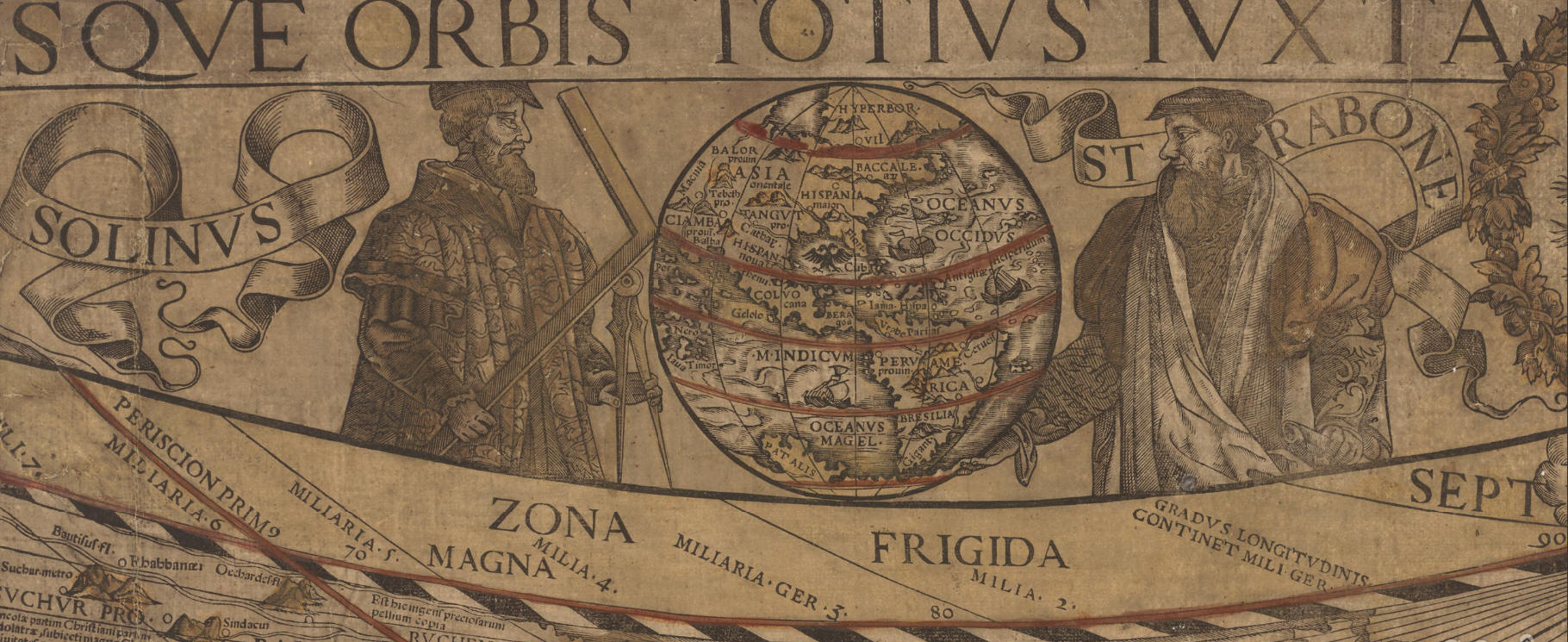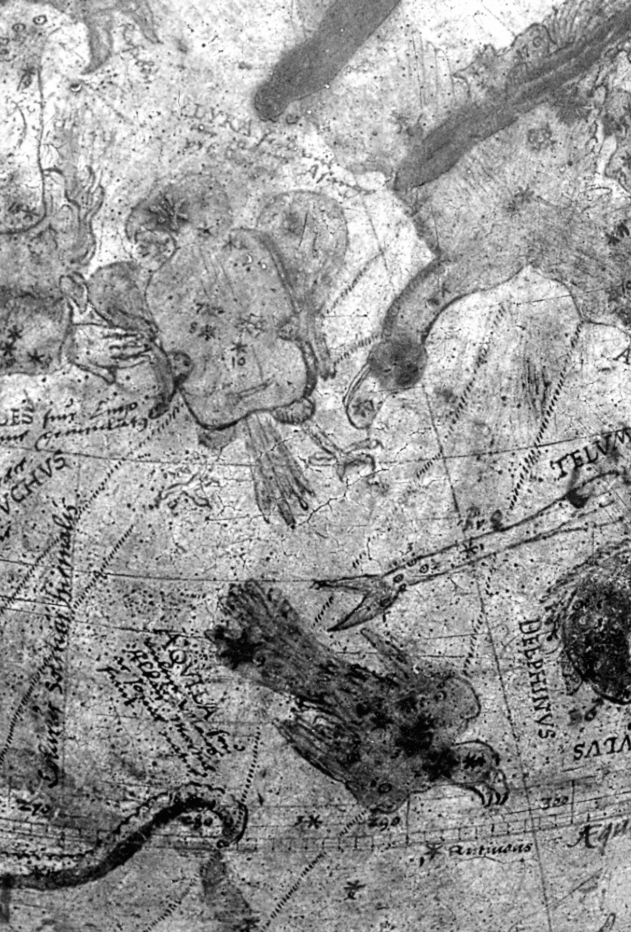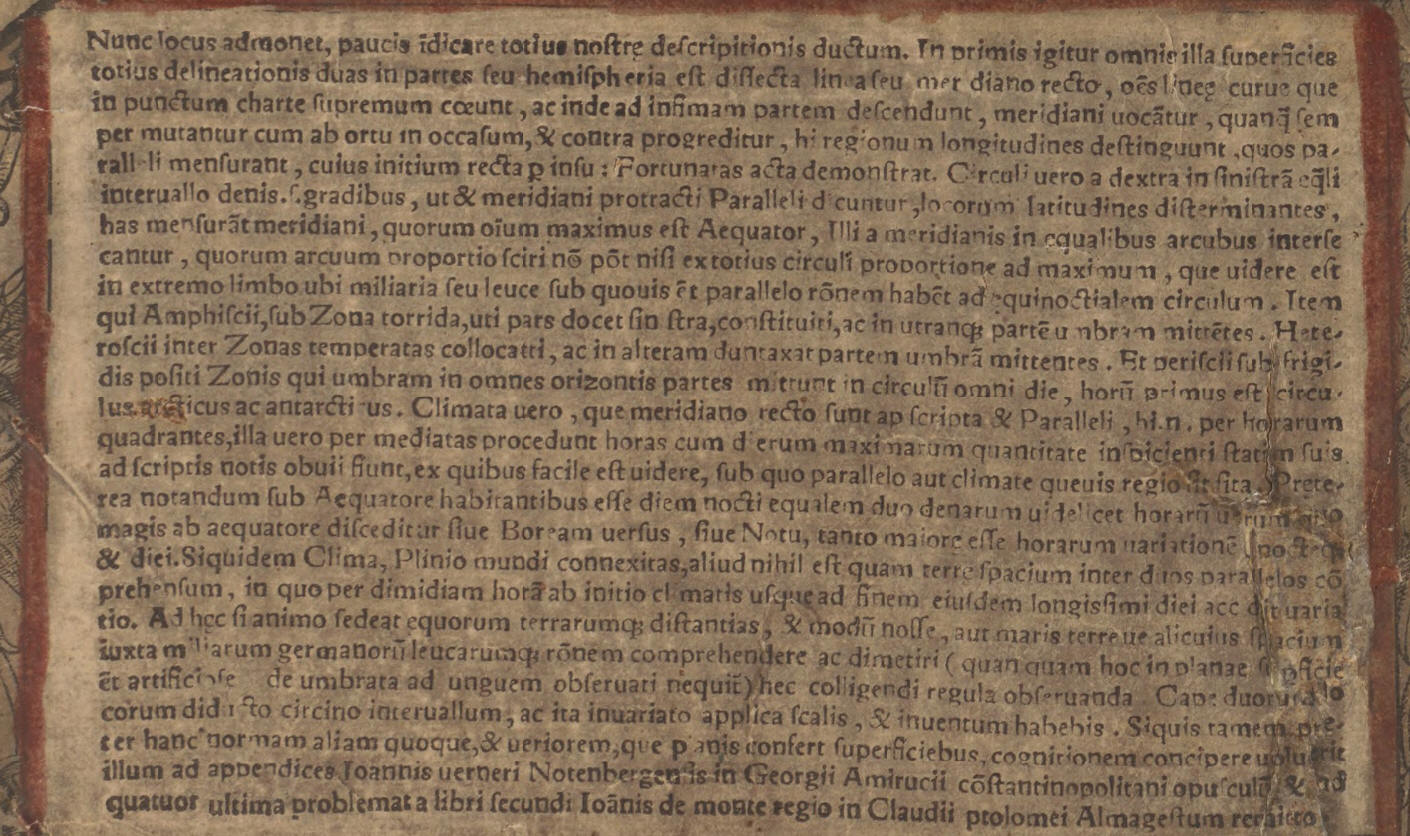
|
Giovanni Andrea Valvassori detto Guadagnino |
Nova et integra universalisque orbis totius iuxta germanum neotericorum traditionem descriptio- Gaspar Vopellius Medeb. 1558 Mathemati conscripsit. Impressum Venetiis per Joannem Andream Vavassorium Cognomine Guadagninus, Venezia 1558
|
Giovanni Andrea Valvassori detto Guadagnino
Nova et integra universalisque orbis totius iuxta germanum neotericorum traditionem descriptio- Gaspar Vopellius Medeb. 1558 Mathemati conscripsit. Impressum Venetiis per Joannem Andream Vavassorium Cognomine Guadagninus, Venezia 1558

Guarda il filmato:
Valvassori, Nova et integra, Venezia 1558.mp4
La tavola di Giovanni Andrea Valvassori, 112,5 cm per 194, che riproduce il globo terrestre su dodici pannelli in proiezione cordiforme contiene negli angoli in basso la proiezione di due planisferi celesti da ascrivere alla tradizione di quelli del cinquecento che hanno per riferimento quelli del Dürer del 1515. Nel suo complesso la tavola ripropone quasi esattamente, sia per lo stile che per il contenuto, quella analoga di Caspar Vopel del 1545, ora andata perduta, nella quale i particolari dei planisferi celesti avevano per modello il globo celeste manoscritto del 1532 di questo autore, ora depositato al Kölnische Stadtmuseum di Colonia:

http://www.atlascoelestis.com/Vopel%202010%20base.htm
https://www.meteo-maarssen.nl/lib_vopel_1536.html
Nella tavola di Valvassori è riprodotto il globo terrestre in proiezione cordiforme

(https://www.movio.beniculturali.it/bnm/ridottiprocuratorisanmarco/it/162/le-mappe-cordiformi)
al quale fanno da cornice le personificazione dei venti con relativa ruota, la ruota dei punti cardinali, due globi terrestri sorretti da personaggi storici e, nella parte inferiore, i due planisferi celesti posti nei relativi angoli:
Imagines Celi Septentrionales cum duodecim Imaginibus Zodiaci, presentato da Ptolomeus Aegyptius e Azophi Arabus, 37,5 cm per 48,5.


Ptolomeus Aegyptius

Azophi Arabus
Imagines Celli Meridionalis, presentato da M. Manilius Omanus e Aratus Cilix, 37,5 cm per 48,5.


M. Manilius Omanus

Aratus Cilix
Ognuno dei dodici pannelli presenta uno o più riquadri scritti in lingua latina che descrivono i relativi contenuti.

Riquadro descrittivo che affianca il planisfero celeste boreale

Riquadro descrittivo che affianca il planisfero celeste boreale
La tavola è proposta per cortesia di Harvard Library IDS

https://iiif.lib.harvard.edu/manifests/view/ids:7723780
https://www.meteo-maarssen.nl/lib_vopel_1536.html














La descrizione dei due planisferi celesti che segue è tratta dall' articolo di Elly Dekker:
1) Northern hemisphere in the lower left corner of the world map entitled: IMAGINES CELI SEPTEN / TRIONALES CVM DVODECIM / IMAGINIBVS ZODIACI. Outside the map are two figures. One, labelled PTOLOME / VS / AEGYP / TIVS, wears a top hat and holds a pair of dividers with a celestial globe in his left hand. The other figure, labelled AZOPHI / ARABVS, wears a turban and holds a celestial globe in both hands.
.jpg)
A) Cartography: Polar stereographic projection from the north ecliptic pole to south of the ecliptic to include the zodiacal constellations. Language: Latin and Greek. Coordinates: circles of latitude every 30°. The ecliptic is graduated [twelve times 0°–30°; numbered every 5°, division 1°]. The names and symbols of the zodiacal signs are absent. The part of equator north of the ecliptic is drawn. It is not graduated and not labelled. The north equatorial pole is labelled Polus mundi Arcticus. The north polar circle is drawn and labelled: Circ Arcticus. The Tropic of Cancer is drawn and labelled: Tropicus Cancri. The equinoctial colures (not labelled) are drawn from the vernal to the autumnal equinox passing through the north equatorial pole. The solstitial colures (labelled Colurus Solsticiorum) coincide with the circle of latitude passing through the north ecliptic and equatorial pole.
B) Astronomical notes: All northern and zodiacal Ptolemaic constellations are drawn, and all but one (Draco) are labelled: VRSA MIN / Greek name; VRSA MAIOR / Helice; CEPHEVS; BOOTES / Greek name; CORONA; HERCVLES / Greek name; LYRA, AVIS / Greek name; CASSIOPEIA; PERSEVS; ERICHTHONIVS / Auriga; OPHIVCH / serpentarius; ANGVIS; TELVM; AQVILA; DELPHINVS; EQVICVLVS; PEGASVS; ANDROMEDA; DELTOTON; ARIES / Greek name; TAVRVS / Greek name; GEMINI; CANCER / Greek name; LEO; VIRGO / Greek name; LIBRA / Greek name; SCORPIO / Greek name; SAGITARIVS / Greek name; CAPRICORNVS / Greek name; AQVARIVS / Greek name; PISCES / Greek name. Also the groups of unformed stars belonging to Aquila and Leo are labelled respectively: ANTINOVS and BERENICES CRINIS / Greek name. Outside the hemisphere, below Sagittarius, is the text: Ante genu Sagitarij Corona est constituta quam Vraniscum vo. There are labels for a number of star groups: Plaustrum (located near the head of Ursa Maior), C. ALGOL (Per), Præsepe (Cnc), Asini (Cnc), Vrna (Aqr), Nodvs coelestis / Greek name (Psc), and for the Milky Way: GALAXIAS.

SCORPIO e indicato come Nebula l'ammasso M7 o Ammasso di Tolomeo

Plaustrum

Præsepe, Asini

Nodvs coelestis
C) The stars are presented by six different marks to indicate their brightness or magnitude. Outside the map, below Sagittarius, is a table labelled Stellarum magnitudines, with magnitudes from 1–6, and alongside these the number of stars within each magnitude class [15, 45, 208, 474, 217, 49]. The stars of the Pleiades are missing. There are planetary symbols for astrological associations, and many stars are labelled: Abrachaleus / Herculis (β Gem), Aldebaran (α Tau), Alhaior (α Aur), Alioth (ϵ UMa), Alkair (α Aql), Alkor/ Equitator (near ζ UMa), Alrucuba (αUMi), Anhelar / Apolinis (α Gem), Arcturus / Azimech aramer / Alramech (α Boo), Benenatz (η UMa), Capra (α Aur), Deneb algedi (δ Cap), Denebeneced (β Leo), Dubhe (α UMa), Fomahant (α PsA), Makab (α Peg), Mirach (β And), Propus (η Gem), Rass Alangue (α Oph), Regulus / Cabalezet / Greek name (α Leo), Rasdagel (β Per), Scheat (δ Aqr), SPICA / Azimech / Greek name (α Vir), Stella polaris (α UMi), Vindemiator (ϵ Vir), Greek name for Antares (α Sco).

Cartiglio delle magnitudini, Stellarum magnitudines

Planetary symbols for astrological associations
D) Iconographic features: The style follows that of Dürer but with some differences: Lyra is a headless bird (note that the orientation of the string instrument differs from that on Vopel's globe by being being placed vertically over the body, as on Dürer's map); Boötes is presented with lance, sickle and hunting dogs, and a goat is eating leaves from a vine above his head; one of the Gemini has a lyre or similar instrument without bow. In addition there are images of Antinous and Coma Berenices comprising the unformed stars belonging to Aquila and Leo, respectively.

Lyra

Coma Berenices e Boötes con i Cani da caccia posti in una posizione diversa da quella che occuperanno come costellazione

Gemini

Antinous
2) Southern hemisphere in the lower right corner of the world map entitled: IMAGINES CELLI / MERIDIONALIS. Outside the map are two figures. One, labelled M. MANILIVS / OMANVS [sic], wears a headband and holds a celestial globe in his left hand. The other, labelled ARATVS / CILIX, wears a hood and has a celestial globe on front of him.
.jpg)
A) Cartography: Polar stereographic projection: from the south ecliptic pole to the ecliptic. Language: Latin and Greek. Coordinates: circles of latitude every 30°. The ecliptic is graduated [twelve times 0°–30°; numbered every 5°, division 1°]. The south ecliptic pole is labelled: Polus Zodiaci. The part of equator south of the ecliptic is drawn. It is labelled: PARS CIRC AEQVINOC but it is not graduated. The south equatorial pole is labelled: POLVS mundi antarct. The south polar circle is drawn and labelled: CIRC. ANTARCTI. The Tropic of Capricorn is drawn and labelled: TROPICVS CAPRICOR. The equinoctial colures, labelled COLVRVS AEQVINOCTIORVM, are drawn from the autumnal to the vernal equinox passing through the south equatorial pole. The solstitial colures, labelled COLVRVS SOLSTICIORVM, coincide with the circle of latitude passing through the south ecliptic and equatorial pole. Below the title is a nonlinear latitude scale, labelled: REGVLA LATITVDINVM STELLARVM [0°–90°; numbered every 10°, division 1°].
B) Astronomical notes: All southern Ptolemaic constellations are drawn and labelled: CETVS / Balena Pristis Leo marinus, ORION, ERIDANVS, LEPVS / Greek name, CANIS MAIO, CANIS MI. / Greek name, ARGO, HYDRA, CRATER, CORVVS, CENTAV. / Phyllirides Chiron, FERA / Greek name, ARA/ Greek name, CORONA AV / Greek name, PISCIS NOTIVS. Close to Corona Australis is the text: Hanc nonnulli Vraniscum vocauere. There are labels for a number of star groups: Succulæ / Greek name (Tau), Tauri caput (Tau), Geminorum stellæ (Gem), Scorpij stellæ (Sco), Nebula Scorpij (Sco), Sagitta (Sgr), Cauda Capricorni (Cap) and Nodvs coelestis (Psc); and for the Milky Way: Via lactea.

Succulæ , Tauri caput

Nebula Scorpij: l'ammasso M7 o Ammasso di Tolomeo
C) The stars are presented by six different marks to indicate their brightness or magnitude. There are planetary symbols for astrological associations, and many stars are labelled: Acarnar (θ Eri), Aldebaran / Greek name spelled Λαμπαδιας (α Tau), Algomeysa (α CMi), Algorab (γ Crv), Alphard (α Hya), Angetenar (τ Eri), Bata Kaitos (ζ Cet), Bedelgeuze (α Ori), CANOP (α Car), Deneb algedi (δ Cap), Deneb Kaytos (β Cet), Fomahant (α PsA), Menkar (α Cet), Rigel / Algebar (β Ori), the Greek name for Antares (α Sco).
D) Iconographic features: The style follows Dürer but with two deviations: a cloud of smoke rises from Ara and a swimming maiden is at the end of Eridanus.

Una nuvola di fumo sale da Ara

Fetonte rappresentato in sembianze femminili che nuota nell'Eridanus
Per cortesia di

e di Hans Gaab autore di

esamina nelle seguenti pagine le influenze delle tavole del Dürer sulla produzione cartografica celeste successiva
e le carte che hanno influito sulla sua produzione
Von Dürer beeinflusste Himmelskarten

https://www.astronomie-nuernberg.de/index.php?category=duerer&page=sternkarten
https://www.astronomie-nuernberg.de/index.php?category=duerer&page=nachfolger
https://www.astronomie-nuernberg.de/index.php?category=duerer&page=valvassore-1558
Consulta anche
Hieronymo de Girava
Typo de la carta cosmographica de Gaspar Vopellio Medeburgense
in
Dos Libros de Cosmographia. Milan: G.A. Castiglione and C. Carron, Milano 1556
http://www.atlascoelestis.com/Girava%201556.htm
Giovanni Antonio Rusconi
Della architettura di Gio. Antonio Rusconi, con centossanta figure dissegnate dal medesimo, secondo i precetti di Vitruvio, Venezia, 1590
http://www.atlascoelestis.com/Rusconi%20Pagina%20base.htm
http://www.atlascoelestis.com/Rusconi%20%20e%20besta.htm

e
La creazione del cielo a Palazzo Besta, Teglio 1550 circa
http://www.atlascoelestis.com/1.htm

Bibliografia:
- Elly Dekker: Caspar Vopel's ventures in Sixteenth-Century Celestial Cartography. Imago Mundi 62/2 (2010), S. 161-190
- Lo stesso articolo con ampio commento iconografico in: http://www.atlascoelestis.com/Vopel%202010%20base.htm
- Rodney W. Shirley: The Mapping of the World. Early printed World Maps 1472-1700. London: The Holland Press 1983, S. 115-118
- Astronomie in Nürnberg, Die Weltkarte von Giovanni Andrea Valvassori von 1558, in Von Dürer beeinflusste Himmelskarten:
https://www.astronomie-nuernberg.de/index.php?category=duerer&page=valvassore-1558
- Giovanni Andrea Valvassori detto Guadagnino: Nova et integra universalisque orbis totius iuxta germanum neotericorum traditionem
descriptio- Gaspar Vopellius Medeb. 1558 Mathemati conscripsit. Impressum Venetiis per Joannem Andream Vavassorium Cognomine Guadagninus, Venezia 1558:
http://www.atlascoelestis.com/Valvassori%201558.htm
- Atlas Coelestis di Felice Stoppa: La creazione del cielo a Palazzo Besta, Teglio:
http://www.atlascoelestis.com/1.htm
- Felice Stoppa: La creazione del cielo / Autore anonimo del 16° secolo. Milano: Salviati Editore 2009
di FELICE STOPPA
LUGLIO 2019
